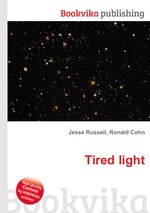Tired light
Jesse Russell Ronald Cohn
бумажная книга
High Quality Content by WIKIPEDIA articles! Tired light is a class of hypothetical redshift mechanisms that was proposed as an alternative explanation for the redshift-distance relationship. These models have been proposed as alternatives to the metric expansion of space of which the Big Bang and the Steady State cosmologies are the most famous examples. The concept was first proposed in 1929 by Fritz Zwicky, who suggested that if photons lost energy over time through collisions with other particles in a regular way, the more distant objects would appear redder than more nearby ones. Zwicky himself acknowledged that any sort of scattering of light would blur the images of distant objects more than what is seen. Additionally, the surface brightness of galaxies evolving with time, time dilation of cosmological sources, and a thermal spectrum of the cosmic microwave background have been observed — these effects that should not be present if the cosmological redshift was due to any tired light scattering mechanism. Despite periodic re-examination of the concept, tired light has not been supported by observational tests and has lately been consigned to consideration only in the fringes of astrophysics.


